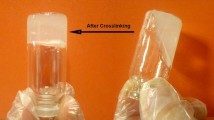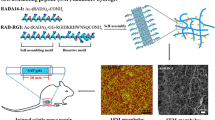Abstract
In the present study, collagen hydrogel containing naringin was fabricated, characterized and used as the scaffold for peripheral nerve damage treatment. The collagen was dissolved in acetic acid, naringin added to the collagen solution, and cross-linked with 1-ethyl-3-(3-dimethylaminopropyl)-carbodiimide powder (EDC; 0.10 mM) to form the hydrogel. The microstructure, swelling behavior, biodegradation, and cyto/hemocompatibility of the fabricated hydrogels were assessed. Finally, the healing efficacy of the prepared collagen hydrogel loaded with naringin on the sciatic nerve crush injury was assessed in the animal model. The characterization results showed that the fabricated hydrogels have a porous structure containing interconnected pores with the average pore size of 90 µm. The degradation results demonstrated that about 70% of the primary weight of the naringin loaded hydrogel had been lost after 4 weeks of storage in PBS. The in vitro study showed that the proliferation of Schwann cells on the collagen/naringin hydrogel was higher than the control group (tissue culture plate) at both 48 and 72 h after cell seeding and even significantly higher than pure collagen 72 h after cell seeding (*p < 0.005, **p < 0.001). The animal study implied that the sciatic functional index reached to −22.13 ± 3.00 at the end of 60th days post-implantation which was statistically significant (p < 0.05) compared with the negative control (injury without the treatment) (−82.60 ± 1.06), and the pure collagen hydrogel (−59.80 ± 3.20) groups. The hot plate latency test, the compound muscle action potential, and wet weight-loss of the gastrocnemius muscle evaluation confirmed the positive effect of the prepared hydrogels on the healing process of the induced nerve injury. In the final, the histopathologic examinations depicted that the collagen/naringin hydrogel group reduced all the histological changes induced from the nerve injury and showed more resemblance to the normal sciatic nerve, with well-arranged fibers and intact myelin sheath. The overall results implied that the prepared collagen/naringin hydrogel can be utilized as a sophisticated alternative to healing peripheral nerve damages.












Similar content being viewed by others
References
Wang EW, Zhang J, Huang JH. Repairing peripheral nerve injury using tissue engineering techniques. Neural Regener Res. 2015;10:1393.
Özkan HS, Karatas Silistreli O, Ergur B, İrkoren S. Repairing peripheral nerve defects by vein grafts filled with adipose tissue derived stromal vascular fraction: an experimental study in rats. Ulus Travma Acids Cerrahi Derg. 2016;22:7–11.
Wang H, Wu J, Zhang X, Ding L, Zeng Q. Study of synergistic role of allogenic skin-derived precursor differentiated Schwann cells and heregulin-1β in nerve regeneration with an acellular nerve allograft. Neurochem Int. 2016;97:146–53.
Oprych KM, Whitby RL, Mikhalovsky SV, Tomlins P, Adu J. Repairing peripheral nerves: is there a role for carbon nanotubes? Adv Healthc Mater. 2016;5:1253–71.
Massoumi B, Hatamzadeh M, Firouzi N, Jaymand M. Electrically conductive nanofibrous scaffold composed of poly (ethylene glycol)-modified polypyrrole and poly (ε-caprolactone) for tissue engineering applications. Mater Sci Eng: C. 2019;98:300–10.
Mozaffari Z, Hatamzadeh M, Massoumi B, Jaymand M. Synthesis and characterization of a novel stimuli‐responsive magnetite nanohydrogel based on poly (ethylene glycol) and poly (N‐isopropylacrylamide) as drug carrier. J Appl Polym Sci. 2018;135:46657.
Massoumi B, Mozaffari Z, Jaymand M. A starch-based stimuli-responsive magnetite nanohydrogel as de novo drug delivery system. Int J Biol Macromolecules. 2018;117:418–26.
Poorgholy N, Massoumi B, Jaymand M. A novel starch-based stimuli-responsive nanosystem for theranostic applications. Int J Biol Macromolecules. 2017;97:654–61.
Abbasian M, Massoumi B, Mohammad-Rezaei R, Samadian H, Jaymand M. Scaffolding polymeric biomaterials: are naturally occurring biological macromolecules more appropriate for tissue engineering? Int J Biol Macromolecules. 2019;134:673–94.
Samadian H, Mobasheri H, Hasanpour S, Faridi-Majid R. Needleless electrospinning system, an efficient platform to fabricate carbon nanofibers. J Nano Res. 2017;50:78–89.
Casolaro M, Casolaro I. Polyelectrolyte hydrogel platforms for the delivery of antidepressant drugs. Gels. 2016;2:24.
Sgambato A, Cipolla L, Russo L. Bioresponsive hydrogels: chemical strategies and perspectives in tissue engineering. Gels. 2016;2:28.
Adibi-Motlagh B, Lotfi AS, Rezaei A, Hashemi E. Cell attachment evaluation of the immobilized bioactive peptide on a nanographene oxide composite. Mater Sci Eng: C.2018;82:323–9.
Ehterami A, Salehi M, Farzamfar S, Vaez A, Samadian H, Sahrapeyma H. In vitro and in vivo study of PCL/COLL wound dressing loaded with insulin-chitosan nanoparticles on cutaneous wound healing in rats model. Int J Biol Macromolecules. 2018;117:601–9.
Ai A, Behforouz A, Ehterami A, Sadeghvaziri N, Jalali S, Farzamfar S. Sciatic nerve regeneration with collagen type I hydrogel containing chitosan nanoparticle loaded by insulin. Int J Polym Mater Polym Biomater. 2019;68:1–10.
Yoshii S, Oka M. Collagen filaments as a scaffold for nerve regeneration. J Biomed Mater Res. 2001;56:400–5.
Phillips JB, Bunting SC, Hall SM, Brown RA. Neural tissue engineering: a self-organizing collagen guidance conduit. Tissue Eng. 2005;11:1611–7.
Kemp SW, Syed S, Walsh SK, Zochodne DW, Midha R. Collagen nerve conduits promote enhanced axonal regeneration, schwann cell association, and neovascularization compared to silicone conduits. Tissue Eng Part A. 2009;15:1975–88.
Chen R, Qi Q-L, Wang M-T, Li Q-Y. Therapeutic potential of naringin: an overview. Pharm Biol. 2016;54:3203–10.
Rong W, Wang J, Liu X, Jiang L, Wei F, Hu X. Naringin treatment improves functional recovery by increasing BDNF and VEGF expression, inhibiting neuronal apoptosis after spinal cord injury. Neurochem Res. 2012;37:1615–23.
Rong W, Pan Y-W, Cai X, Song F, Zhao Z, Xiao S-H. The mechanism of Naringin-enhanced remyelination after spinal cord injury. Neural Regen Res. 2017;12:470.
Wang D, Yan J, Chen J, Wu W, Zhu X, Wang Y. Naringin improves neuronal insulin signaling, brain mitochondrial function, and cognitive function in high-fat diet-induced obese mice. Cell Mol Neurobiol. 2015;35:1061–71.
Salehi M, Naseri-Nosar M, Ebrahimi-Barough S, Nourani M, Vaez A, Farzamfar S. Regeneration of sciatic nerve crush injury by a hydroxyapatite nanoparticle-containing collagen type I hydrogel. J Physiological Sci. 2018;68:579–87.
Ehterami A, Salehi M, Farzamfar S, Samadian H, Vaeez A, Ghorbani S. Chitosan/alginate hydrogels containing Alpha-tocopherol for wound healing in rat model. J Drug Deliv Sci Technol. 2019;51:204–213.
Salehi M, Naseri-Nosar M, Azami M, Nodooshan SJ, Arish J. Comparative study of poly (L-lactic acid) scaffolds coated with chitosan nanoparticles prepared via ultrasonication and ionic gelation techniques. Tissue Eng Regener Med. 2016;13:498–506.
Salehi M, Naseri‐Nosar M, Ebrahimi‐Barough S, Nourani M, Khojasteh A, Hamidieh AA. Sciatic nerve regeneration by transplantation of Schwann cells via erythropoietin controlled‐releasing polylactic acid/multiwalled carbon nanotubes/gelatin nanofibrils neural guidance conduit. J Biomed Mater Res Part B: Appl Biomater. 2018;106:1463–76.
alehi M, Naseri-Nosar M, Ebrahimi-Barough S, Nourani M, Khojasteh A, Farzamfar S. Polyurethane/gelatin nanofibrils neural guidance conduit containing platelet-rich plasma and melatonin for transplantation of Schwann cells. Cell Mol Neurobiol. 2018;38:703–13.
Aurand ER, Lampe KJ, Bjugstad KB. Defining and designing polymers and hydrogels for neural tissue engineering. Neurosci Res. 2012;72:199–213.
Woerly S. Porous hydrogels for neural tissue engineering. In: Materials Science Forum. Trans Tech Publ; 1997;250:53–68.
Feng G, Nguyen TD, Yi X, Lyu Y, Lan Z, Xia J. Evaluation of long-term inflammatory responses after implantation of a novel fully bioabsorbable scaffold composed of poly-l-lactic acid and amorphous calcium phosphate nanoparticles. J Nanomater. 2018;2018:1–9.
Yin L, Cheng W, Qin Z, Yu H, Yu Z, Zhong M. Effects of naringin on proliferation and osteogenic differentiation of human periodontal ligament stem cells in vitro and in vivo. Stem Cells Int. 2015;2015:47–56.
Dai K-R, Yan S-G, Yan W-Q, Chen D-Q, Xu Z-W. Effects of naringin on the proliferation and osteogenic differentiation of human bone mesenchymal stem cell. Eur J Pharmacol. 2009;607:1–5.
Avia‐Saiz M, Busto MD, Pilar‐Izquierdo MC, Ortega N, Perez‐Mateos M, Muñiz P. Antioxidant properties, radical scavenging activity and biomolecule protection capacity of flavonoid naringenin and its glycoside naringin: a comparative study. J Sci Food Agriculture. 2010;90:1238–44.
Anuja G, Latha P, Suja S, Shyamal S, Shine V, Sini S, et al. Anti-inflammatory and analgesic properties of Drynaria quercifolia (L.) J. Smith. J Ethnopharmacol. 2010;132:456–60.
Choe S-C, Kim H-S, Jeong T-S, Bok S-H, Park Y-B. Naringin has an antiatherogenic effect with the inhibition of intercellular adhesion molecule-1 in hypercholesterolemic rabbits. J Cardiovasc Pharmacol. 2001;38:947–55.
Pereira JE, Costa LM, Cabrita AM, Couto PA, Filipe VM, Magalhães LG. Methylprednisolone fails to improve functional and histological outcome following spinal cord injury in rats. Exp Neurol. 2009;220:71–81.
Ma X, Lv J, Sun X, Ma J, Xing G, Wang Y. Naringin ameliorates bone loss induced by sciatic neurectomy and increases Semaphorin 3A expression in denervated bone. Sci Rep. 2016;6:24562.
Kim HJ, Song JY, Park HJ, Park HK, Yun DH, Chung JH. Naringin protects against rotenone-induced apoptosis in human neuroblastoma SH-SY5Ycells. Korean J Physiol Pharmacol. 2009;13:281–5.
Satou T, Nishida S, Hiruma S, Tanji K, Takahashi M, Fujita S. A morphological study on the effects of collagen gel matrix on regeneration of severed rat sciatic nerve in silicone tubes. Pathol Int. 1986;36:199–208.
Chamberlain L, Yannas I, Hsu H, Strichartz G, Spector M. Collagen-GAG substrate enhances the quality of nerve regeneration through collagen tubes up to level of autograft. Exp Neurol. 1998;154:315–29.
Goto E, Mukozawa M, Mori H, Hara M. A rolled sheet of collagen gel with cultured Schwann cells: model of nerve conduit to enhance neurite growth. J Biosci Bioeng. 2010;109:512–8.
Kim HD, Jeong KH, Jung UJ, Kim SR. Naringin treatment induces neuroprotective effects in a mouse model of Parkinson’s disease in vivo, but not enough to restore the lesioned dopaminergic system. J Nutr Biochem. 2016;28:140–6.
Rong W, Cai X, Pan Y, Song F, Zhang C, Xiao S. Combination therapy of chitosan conduit and naringin facilitate regeneration of injured sciatic nerve in rats. In: BIBE 2018; International Conference on Biological Information and Biomedical Engineering. VDE 2018. pp 1–4.
Acknowledgements
The authors gratefully acknowledge the research council of Kermanshah University of Medical Sciences (grant no. 980264) for financial support.
Author information
Authors and Affiliations
Corresponding author
Ethics declarations
Conflict of interest
The authors declare that they have no conflict of interest.
Additional information
Publisher’s note Springer Nature remains neutral with regard to jurisdictional claims in published maps and institutional affiliations.
Rights and permissions
About this article
Cite this article
Samadian, H., Vaez, A., Ehterami, A. et al. Sciatic nerve regeneration by using collagen type I hydrogel containing naringin. J Mater Sci: Mater Med 30, 107 (2019). https://doi.org/10.1007/s10856-019-6309-8
Received:
Accepted:
Published:
DOI: https://doi.org/10.1007/s10856-019-6309-8




